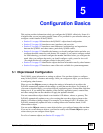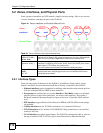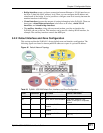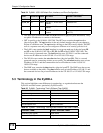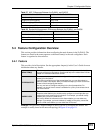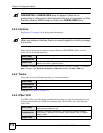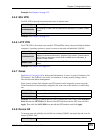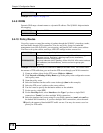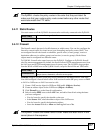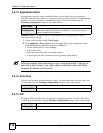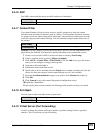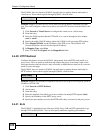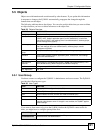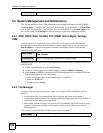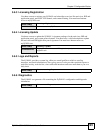
Chapter 5 Configuration Basics
ZyWALL USG 100/200 Series User’s Guide
116
Example: See Chapter 6 on page 125.
5.4.9 DDNS
Dynamic DNS maps a domain name to a dynamic IP address. The ZyWALL helps maintain
this mapping.
5.4.10 Policy Routes
Use policy routes to control the routing of packets through the ZyWALL’s interfaces, trunks,
and send traffic through VPN connections. You also use policy routes for bandwidth
management (out of the ZyWALL), port triggering, and general NAT on the source address.
You have to set up the criteria, next-hops, and NAT settings in other screens first.
Example: You have an FTP server connected to dmz (in the DMZ zone). You want to limit
the amount of FTP traffic that goes out from the FTP server through your WAN connection.
1 Create an address object for the FTP server (Object > Address).
2 Click Network > Routing > Policy Route to go to the policy route configuration screen.
Add a policy route.
3 Name the policy route.
4 Select the interface that the traffic comes in through (dmz in this example).
5 Select the FTP server’s address as the source address.
6 You don’t need to specify the destination address or the schedule.
7 For the service, select FTP.
8 For the Next Hop fields, select Interface as the Type if you have a single WAN
connection or Trunk if you have multiple WAN connections.
9 Select the interface that you are using for your WAN connection (wan1 and wan2 are
the default WAN interfaces). If you have multiple WAN connections, select the trunk.
10 Specify the amount of bandwidth FTP traffic can use. You may also want to set a low
priority for FTP traffic.
PREREQUISITES
Interfaces (with a static IP address), to-ZyWALL firewall
MENU ITEM(S)
Network > DDNS
PREREQUISITES
Interface
MENU ITEM(S)
Network > Routing > Policy Route
PREREQUISITES
Criteria: users, user groups, interfaces (incoming), IPSec VPN (incoming),
addresses (source, destination), address groups (source, destination),
schedules, services, service groups
Next-hop: addresses (HOST gateway), IPSec VPN, SSL VPN, trunks, interfaces
NAT: addresses (translated address), services and service groups (port
triggering)




